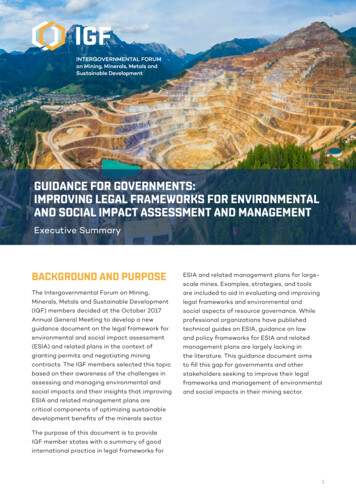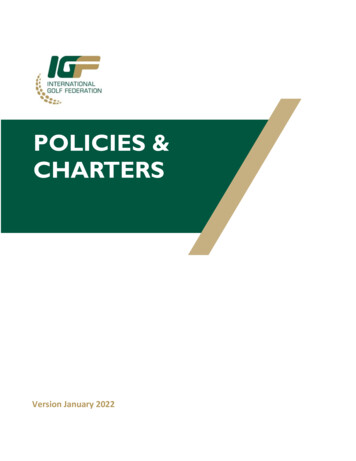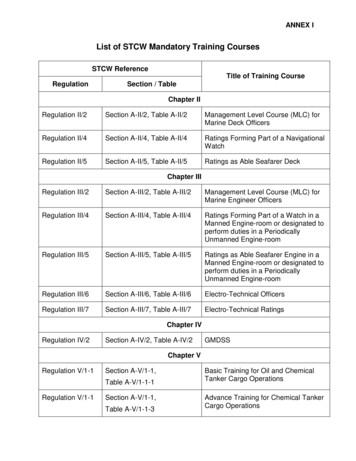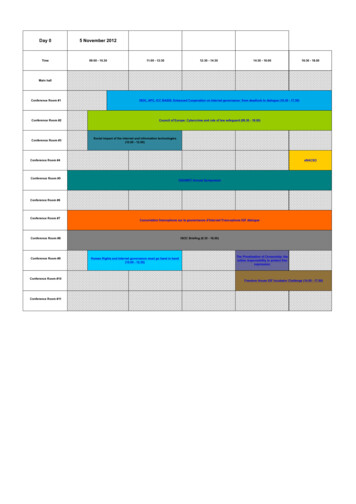
Transcription
GUIDANCE FOR GOVERNMENTS:IMPROVING LEGAL FRAMEWORKS FOR ENVIRONMENTALAND SOCIAL IMPACT ASSESSMENT AND MANAGEMENTExecutive SummaryBACKGROUND AND PURPOSEThe Intergovernmental Forum on Mining,Minerals, Metals and Sustainable Development(IGF) members decided at the October 2017Annual General Meeting to develop a newguidance document on the legal framework forenvironmental and social impact assessment(ESIA) and related plans in the context ofgranting permits and negotiating miningcontracts. The IGF members selected this topicbased on their awareness of the challenges inassessing and managing environmental andsocial impacts and their insights that improvingESIA and related management plans arecritical components of optimizing sustainabledevelopment benefits of the minerals sector.ESIA and related management plans for largescale mines. Examples, strategies, and toolsare included to aid in evaluating and improvinglegal frameworks and environmental andsocial aspects of resource governance. Whileprofessional organizations have publishedtechnical guides on ESIA, guidance on lawand policy frameworks for ESIA and relatedmanagement plans are largely lacking inthe literature. This guidance document aimsto fill this gap for governments and otherstakeholders seeking to improve their legalframeworks and management of environmentaland social impacts in their mining sector.The purpose of this document is to provideIGF member states with a summary of goodinternational practice in legal frameworks for1
IMPORTANCE OF LEGALFRAMEWORKS FORENVIRONMENTAL AND SOCIALIMPACT ASSESSMENT ANDMANAGEMENTan environmental and social legacy forWhen improperly regulated, mining activitiesframework for ESIA and environmental andhave the potential to harm the environmentsocial management.communities and governments. The growingnumber of international disputes related tounclear processes for environmental andsocial management of the mining sector isa testimony to the importance of a clear,transparent, and comprehensive legaland disrupt social and economic structureswithin a community, instead of capturing themany benefits that can flow from the sector.ESIAs and related tools, such as Environmentaland Social Management Plans (ESMPs), arethus critical components in legal frameworksfor mining activities, both to minimize thenegative impacts and to optimize the positivecontributions of the mining sector.ENVIRONMENTAL AND SOCIALIMPACT ASSESSMENTSAND MANAGEMENT PLANSARE IMPORTANT TOOLS FORGOVERNMENTSESIA is a tool used to identify and evaluate theWith mining activities taking place inpotential environmental and social impactsjurisdictions with varying levels of social andof a project. ESMPs are developed during theenvironmental protection, a survey of bestESIA process and propose actions to respondpractices for the governance of environmentalto, mitigate, and manage identified impactsand social impacts and benefits of miningand benefits.through all phases of the life cycle of themine, from exploration through the postmining transition, is fundamental. When thelegal framework adequately addresses thetiming, scope, implementation, monitoring, andenforcement processes of ESIA and relatedmanagement frameworks, governmentsand other stakeholders have a roadmap formanaging impacts and optimizing social andGovernment review of ESIAs and relatedmanagement plans is a key component in agovernment’s decision regarding whether aproposed mining project should be approvedor not. The process helps governments tocarefully consider how the proposed project willbe implemented, to ensure that it proceeds onlyin a manner that protects the environment andeconomic benefits from the mining sector.advances the social and economic interestsUnfortunately, the environmental and socialmineral development permit is granted, ESMPsimpacts of mining are often not properlythen serve as a reference document for theconsidered before mining activity begins.Regulatory shortcomings and proceduralflaws in the ESIA process, monitoring, andenforcement can have negative repercussions:of current and future generations. Where apermit holder, government monitoring agencies,communities, and other key stakeholdersthroughout the life of the mining project.trust between mining proponents, governments,The legal framework should provide a clearand communities can be jeopardized; minesroadmap for the environmental and socialcan operate with inadequate ESMPs; andimpact assessment and managementmine closure plans and related financialprocess, incorporating practices that aidguarantees are often insufficient. In somethe government in meeting all aspects of itscases, mines are simply abandoned, leavingsustainable development objectives.2
ORGANIZATION OF THIS GUIDANCE DOCUMENTFIGURE 1. ORGANIZATION OF THE GUIDANCE DOCUMENT1.0 Importance of a Comprehensive Legal FrameworkSECTION A:Setting the Stage2.0 Key Concepts: The Basics of ESIA and ManagementSECTION B:Good Legal FrameworkComponents and EnablingMechanismsSECTION C:Key GovernmentActions by Phase3.0 Components of a Comprehensive Legal Framework4.0 Enabling Factors and Mechanisms5.0 Screening Process Through the Exploration Phase6.0 Environmental and Social Impact Assessments ProcessThrough the Mine Planning Phase7.0 Monitoring, Inspections, and Enforcement ThroughConstruction and Operation Phases8.0 Ensure Impacts Are Managed Throughout Closure,Relinquishment, and Post-ClosureSECTION D:How to Improve Your LegalFramework in Practice9.0 Strategies for Assessing and Revising Your Legal Framework10.0 Good Governance ChecklistESIA ISDS Cases TableKey IssuesDefinition of Key ConceptsAdditional References by TopicANNEXES3
This guidance document is organized into fourdetermine when a proposed mine needs afull ESIA and related government reviewprocess.sections and 10 chapters.Section A sets the stage for the guidancedocument. It consists of two chapters: Chapter 1 provides an overview ofthe importance and key benefits ofa comprehensive legal frameworkfor environmental and social impactassessment and management. Thischapter presents current trends inenvironmental and social impactassessment and management plansacross the jurisdictions studied in thepreparation of this guidance document,as well as trends in international disputesrelated to ESIA in the mining sector.Chapter 2 explains what an ESIA isand lays out the key steps of and keystakeholders in the ESIA process. Thischapter also describes the mine life cycle,common impacts across each stage ofthe life of the mine, and types of ESMPsto help respond to and manage theseimpacts.Section B provides an overview of a good legalframework for environmental and social impactassessment and management. It includes twochapters: Chapter 3 identifies 20 componentsof a comprehensive legal frameworkfor environmental and social impactassessment and management plans forthe mining sector and proceeds with adiscussion of each component.Chapter 4 provides an overview of keyenabling factors and mechanisms ofa good framework for environmentaland social impact assessment andmanagement.Section C presents key government actions overfour phases, each in its own chapter: Chapter 5 describes the screeningprocess and steps the government canutilize through the exploration phase to Chapter 6 covers the ESIA review processand related requirements through themine planning phase, culminating in thegovernment’s decision to approve ordeny the environmental authorizationand transfer of any conditions of projectapproval to subsequent permits. Chapter 7 covers monitoring, inspections,and enforcement roles through theconstruction and operations phases toensure that environmental and socialimpacts and socioeconomic benefits arecontinually managed. Chapter 8 describes governmentmanagement of the final steps of closure,relinquishment, and post-closure, and theimportance of regular review and updatesof mine closure plans to ensure thatsocial and environmental aspects of mineclosure are addressed in the event of atemporary or permanent mine closure.Section D covers how to improve your legalframework in practice. This section includestwo chapters: Chapter 9 details strategies forassessing and revising legal frameworksfor ESIA and environmental and socialmanagement of the mining sector andprovides actionable steps. Chapter 10 provides a detailed list ofassessment questions and tools toguide assessing and improving legalframeworks. The lists are alignedwith each substantive chapter of thisguidance document.The Annex to this document provides additionaltools, including definitions of key conceptsrelated to ESIA and environmental and socialmanagement, a bibliography, and a list ofadditional references by topic.4
KEY RECOMMENDATIONSCOMPONENTS OF ACOMPREHENSIVE LEGALFRAMEWORK FOR ENVIRONMENTALAND SOCIAL IMPACT ASSESSMENTAND MANAGEMENTGovernments should adopt a comprehensivelegal framework for environmental and socialimpact assessment and management of themining sector to ensure that it protects theenvironment and optimizes opportunities toadvance sustainable development. Followinga study of a wide range of jurisdictions andreview of good international practice, Chapter3 presents 20 components of a comprehensivelegal framework for environmental and socialimpact assessment and management plans.Commitment to Sustainable Development1.Commitment to sustainabledevelopment, including environmentaland social protection, is stated in thelegal framework.Consistency and Coordination2.Consistency is maintained across alllegal instruments.3.Responsible authorities are clearlyidentified, along with their respectiveroles in review, decision-making, andmonitoring processes.Coverage of All Phases of Mine Life4. Social and environmental requirementsare defined for all phases of the mine life,commensurate with risks.Public Engagement, Consultation, andTransparency5.for public engagement throughout thelife of the mine.6.Requirements and guidelinesregarding transparency and access toenvironmental and social information areprovided.Grievance Mechanisms7.Requirements and guidelines forgrievance mechanisms are provided.ESIA Requirements8.Standard requirements for the initialproject proposal are clearly described.9.Screening procedures are required todetermine when a mining activity willrequire an ESIA and review process.10. Requirements and procedures forscoping are provided, includingrequirements for stakeholder input.11. The ESIA is part of project planning andis conducted before any decisions aremade to approve a proposed large-scalemining project.12. A reasonable timeline for the ESIA reportreview process is defined.Environmental and Social Management Plans13. ESMPs are required in the review process,and guidelines are provided.Mine Closure Plans and Financial Assurance14. Preliminary mine closure and post-miningtransition plans are required in the reviewprocess, and guidelines are provided.15. Adequate financial assurance forremediation and mine closure is requiredand must be maintained by the mininglicence holder.Requirements and guidelines for publicengagement and consultation areprovided, including ongoing requirements5
Permits and Approvals16. Permits and approvals are subject tostandard terms and conditions, includingreporting and updating requirements.ongoing improvement of the legal frameworkand its implementation, it is also fundamentalfor governments to identify sources of fundingand ensure that required human resources arein place.Monitoring, Inspections, and Enforcement17. Oversight of environmental and socialimpacts across the life of the mine isrequired through monitoring, inspections,and enforcement.18. Sanctions for non-compliance arecommensurate with the level of violation.19. Existing permit conditions must be metprior to renewal and prior to approving apermit for large-scale mine development.20. Clear conditions are provided for“exit tickets,” relinquishment, andmanagement of residual risks.This guidance document also identifiesenabling mechanisms and factors in Chapter 4that will support the success of implementinga comprehensive framework for ESIA andESMPs. This includes aligning international,national, and subnational law and policy inorder to ensure consistency across the legalframework. Governments should also avoidlegal stabilization of environmental and socialprovisions in laws and contracts so that theymay continue to improve and update theirlegal framework. Conducting a strategicenvironmental and social assessment (SESA)for the mining sector can also promote greaterunderstanding and clarity for all stakeholdersregarding national and subnationaldevelopment plans, land-use plans, and arange of environmental and social criteria andobjectives. Establishing a coordinating agencyis also important to facilitate inter-ministerialcollaboration and decision making. Anotherkey enabling factor is to ensure meaningfulconsultation and engagement—guidelines canprovide greater clarity for all stakeholders andfoster positive outcomes. Finally, to ensureKEY GOVERNMENT ACTIONS INEACH PHASE OF THE LIFE OF THEMINE TO IMPLEMENT THE LEGALFRAMEWORK FOR ENVIRONMENTALAND SOCIAL IMPACT ASSESSMENTAND MANAGEMENTResponsible management in each phase of thelife of the mine sets the stage for responsiblemanagement of subsequent phases. With thisin mind, government action in the explorationphase cannot be overlooked. Likewise,government actions and decisions in themine planning phase can set a mining projectup for optimal contributions for sustainabledevelopment, from the construction phasethrough mine closure and post-miningtransition. Chapters 5 to 8 present keygovernment actions by mining phase.THE SCREENING PROCESS THROUGH THEEXPLORATION PHASE AND DEFINING WHEN APROJECT NEEDS AN ESIA REVIEW PROCESSThe screening process is critical, as itdetermines when a proposed mining activitywill need a full ESIA, based on the level ofenvironmental and social risks. Establishingclear requirements for managing environmentaland social risks in this exploration phase isvery important to the responsible governanceof the mining sector and often determines the“first impression” of mining for communities.Large-scale mining projects and majorexpansions of mines should always requirean ESIA process. Governments should ensurethat any issued permits and approvals aresubject to standard terms and conditions,with special conditions for exploration and6
other mining activities where required. In sometypes of advanced exploration activity withhigher levels of environmental or social risks,a semi-detailed or full ESIA may be required,for example, where Indigenous Peoples arepresent or exploration requires building a roadthrough a potentially sensitive area. Finally,governments should require existing permitconditions to be met prior to renewal andlarge-scale mine development.THE ESIA PROCESS THROUGH THE MINEPLANNING PHASEThe government’s ESIA review processis critical to determine if and under whatconditions the mining project will be developed,based on identified environmental and socialimpacts and proposed mitigation measures.The government will undertake a reviewof the mine development plan and set outcriteria for project scoping. Government willthen develop and agree to the content ofthe ESIA report, based on stakeholder input,through Terms of Reference (ToR). Throughoutthe mine planning phase, governmentsshould also require and oversee meaningfulengagement and consultation processes,including building stakeholder capacityfor participation. When the ESIA report issubmitted, a lead government agency shouldensure that it is complete and aligned withthe ToR, then coordinate the reviews of allrelevant government agencies and overseethe stakeholder review process. The timelinefor review should be reasonable and maytake years for a large-scale mining project.The government evaluation should include areview of the ESIA report, management plans,closure plans, and other relevant plans. Thereview should ensure that sufficient financialassurance for remediation and mine closureare provided prior to mine development.Based on this evaluation and review process,the government will approve or deny theenvironmental authorization. The decision willbe based on consideration of all technicallyfeasible alternatives, including a “no project”alternative. If approved, all conditions of projectapproval must be transferred to subsequentpermits and monitored for compliance.THE MONITORING, INSPECTIONS, ANDENFORCEMENT PROCESS THROUGH THECONSTRUCTION AND OPERATIONS PHASESOnce a mining project is approved, thegovernment’s role is to ensure thatenvironmental and social impacts andsocioeconomic benefits are continuallymanaged through the construction andoperations phases. Governments willensure that stakeholder and communityengagement and capacity building aremaintained. Government will also ensureongoing transparency in communicatingthe results of compliance and enforcementto communities and the public, includingthrough clear guidelines for environmentaland social reporting. Collaboration betweennational and local governments is particularlyimportant at this stage, to effectivelymanage the impacts and benefits of theworkforce. Governments must also ensurethat progressive rehabilitation is undertakenthroughout the life of the mine, as well asongoing preparation for environmental andsocial aspects of the post-mining transition.Effective monitoring requires governments toconduct regular reviews of progress reports andmonitor the implementation of managementplans. Providing clear inspection requirementsand adequate human resources for compliancechecks and enforcement is also crucial for themonitoring process. Governments may need toenforce permit conditions and manage noncompliance. Where there are material changesto mine plans or impacts, governments mayneed to request updated assessments andamended management plans.7
CLOSURE AND POST-MINING TRANSITIONThis crucial phase involves managing the finalsteps of closure, relinquishment, and postmining transition. The success of this phasebuilds on the quality of mine closure planning,implementation, and monitoring of previousphases. Mine closure planning must address notonly the environmental aspects of mine closurebut also the social and economic aspects ofpost-mining transition. Preparation for mineclosure requires ongoing action through theplanning and operations phases in particularto prepare for temporary and permanentclosures. Governments must regularly reviewmine closure plans, require updates as needed,and ensure that closure planning addressesthe social, environmental, and economicaspects of mine closure. The legal frameworkmust provide clear conditions for “exit tickets,”relinquishment, and management of residualrisks. Finally, governments should inspect andmonitor closure and post-mining transition planimplementation and complete a final inspectionprior to relinquishment.Government and company responsibilities inenvironmental and social impact assessmentand management by mine phase aresummarized in Figure 2.PRACTICAL TOOLS ANDSTEPS TO IMPROVELEGAL FRAMEWORKS FORENVIRONMENTAL AND SOCIALIMPACT ASSESSMENT ANDMANAGEMENTChapter 9 provides governments withpractical steps to review and improve theirlegal framework with an aim to enhanceenvironmental and social protection in themining sector. The first step is to conducta “gap analysis” that compares the legalframework to international good practice.This guidance document and its Chapter 10Good Governance Checklists provide usefulreferences for such an analysis.When considering whether the time is rightfor reforms, the government should prepareby scanning for challenges and opportunities,identifying risks associated with an inadequatereform process, and determining what legalinstruments should be changed. This guidancedocument then provides a process with stepsfor revision, including collaborating throughan inter-agency platform or working group;analyzing by completing the gap analysis;planning and developing an ESIA frameworkthat fills existing gaps; reviewing througha review committee; submitting the draftfor adoption or endorsement; implementingthrough an implementation action planand strategy; and checking, assessing,and monitoring to review and audit theeffectiveness of the plan. Governments shouldput a system in place to manage change andcontinuously monitor, evaluate, and improvelegal frameworks.8
FIGURE 2. GOVERNMENT AND PROPONENT RESPONSIBILITIES IN ENVIRONMENTAL AND SOCIALIMPACT ASSESSMENT AND MANAGEMENT BY MINE LITIESEXPLORATION PHASESemi-detailed ESIA if activities are high/exceptional risksReview semi-detailed ESIA and issue permitsand conditionsExploration monitoring and complianceExploration permitting, inspections,enforcementBaseline studiesBaseline studiesScreening of project proposalProject proposal submissionCoordinate ESIA scopingSupport scopingESIA reviewESIA and ESMP submissionDecisionRespond to requests for informationMine permittingIF YESCONSTRUCTION AND OPERATION PHASESReview of monitoring results, inspections,enforcementESMP implementationMonitoring and compliancePermit amendments and renewalsStakeholder engagement, consultation, and particpationPLANNING PHASEClosure plan updatesCLOSURE AND POST-MINING TRANSITIONImplementation of closure planReview of monitoring results, inspections,enforcementClosure monitoring and complianceIF RELINQUISHMENTLong-term monitoring and responsibility9
LIMITATIONS OF THISGUIDANCE DOCUMENTThis guidance document does not coverartisanal mining or present all the uniquechallenges of small and medium-sized miningoperations. While these are all very importantareas for environmental and social impactmanagement, they require more attention thanis possible in the limited space of this guidancedocument.ADDITIONAL RESOURCESIn addition to the resources provided in theAnnex to this guidance document, you can findadditional information in a range of languagesat www.IGFMining.org. This guidance documentmay lead to additional future resources,including case studies, training courses, andonline materials. If you are interested in moreinformation or would like to request additionaltraining or materials, please contact the IGFSecretariat at secretariat@igfmining.org.The guidance presented in this document,while incorporating the input of technicalexperts, does not set out detailed technicalaspects of conducting ESIAs. The guidancefocuses on international good practices in legalframeworks and key government actions overthe life of a large-scale mine.For more information, contact:1100-220 Laurier Avenue W.Ottawa, OntarioCanada R3B 0T4secretariat@IGFMining.orgIGFMining.org @IGFMiningSecretariat hosted bySecretariat funded by 2020 International Institute for Sustainable Development10
ESIA and related management plans are critical components of optimizing sustainable development benefits of the minerals sector. The purpose of this document is to provide IGF member states with a summary of good international practice in legal frameworks for ESIA and related management plans for large-scale mines. Examples, strategies, and tools










